Downtown Chicago
Downtown Chicago is the place where you will find historic and modern skyscrapers standing side by side and the main shopping area of the city. It is also the focus for Chicago’s renowned elevated railway system. A 2.9 km (1.8 mile) long rectangular circuit built over the streets forms the hub of a local rail system that connects central Chicago to its suburbs. The area inside and close to this loop of elevated railway is known locally as ‘The Loop’.
Union Station from Clinton Street
In 1874 five railroad companies agreed to build a joint station in Chicago so that passengers would no longer need to travel between stations when changing trains. One company backed out of the deal but the remaining four went ahead and Union Station opened in 1881. By the early 20th century, growth had outstripped the capacity of the original Union Station, so in 1913 work began on the construction of a larger and grander station designed by architect Daniel Burnham. The new station opened in 1925 and it thrived until the end of World War II. By 1968 rail traffic had declined and the concourse building was demolished to make way for an office block with a smaller concourse underneath it. Fortunately the main station building with its magnificent Grand Hall survived. Daniel Burnham designed the station to have additional storeys added above the Grand Hall, and since the 1990s there have been several plans use the Grand Hall as the lobby for a multi-use development above it. All train related activities were moved out of the Grand Hall in preparation for this but unfortunately none of the plans have come to fruition. Click Tab 2 to see the Beaux Arts style Great Hall at Union Station. complete with 18 soaring Corinthian columns, terracotta walls, pink Tennessee marble floor and barrel vaulted atrium ceiling.
Click on Minimap to navigate
Great Lawn & Jay Pritzker Pavilion, Millennium Park
Chicago decided to celebrate the millennium in style by creating a 10 hectare (24 acre) park on disused land that had formerly been railroad sidings. Mayor Richard M. Daley had a vision in 1997 of using this land to create a new public space as an extension of the adjacent Grant Park. Work commenced on the construction the new park in 1998. It was named Millennium Park because construction was meant to have been finished in the year 2000, but the work overran and it did not open until 2004. The Jay Pritzker Pavilion is a music pavilion in the park for open air concerts. It is the home of the Grant Park Symphony Orchestra and Chorus.
Wrigley Building & Tribune Tower from Michigan Avenue
The first skyscraper was the The Home Insurance Building built in Chicago in 1885. It was initially only 9 stories high, but was the first example of the steel frame structure since used for much bigger skyscrapers. This picture shows two historic Chicago skyscrapers. The Wrigley Building on the left was constructed between 1920 and 1924 as the headquarters of the chewing gum company. Built on a on a prominent location at the north west corner of Michigan Avenue and the Chicago River, the 130 metre (425 foot) high tower of the Wrigley building is a local landmark. The Tribune tower, on the right, was built as the headquarters of the Chicago Tribune newspaper. A 1920 competition to design the new headquarters was won by New York architects John Howells and Raymond Hood with their plan for a neo-gothic skyscraper. Into the lower levels of the building have been incorporated fragments from famous buildings around the world, such as the Taj Mahal. The Tribune Tower was completed in 1925 and has a height of 141 meters (462 feet). Both buildings are tiny compared to the Willis Tower, but although they lack the height of their modern counterparts, they ooze character that is often missing from more modern skyscrapers.
DLU130729



State Street Station, The El (elevated railway)
The Willis Tower isn’t the only place in Chicago to catch the sunset, as shown here. Elevated railways were cheaper to build than subways so they sprang up in several US cities. The down side of an elevated railway is that street below is dark, the viaduct can obstruct traffic and whenever a train passes overhead it is incredibly noisy. Other cities have since put their railways underground leaving Chicago as now the only major US City with an elevated railway in its downtown area. Originally Chicago had three elevated railway lines, each with its own downtown terminus. Between 1895 and 1897 Philadelphia financier Charles Yerkes linked these lines together by constructing a loop line in the centre of Chicago that formed a hub to unite the lines into a single elevated railway system. The loop follows a rectangular route formed by Lake Street to the north, Wabash Avenue to the east, Van Buren Street to the south and Wells Street to the west. Trains run round the loop in both directions. Charles Yerkes went on to perform a similar unifying role on the London Underground system, although that work was not completed until after his death in 1905.
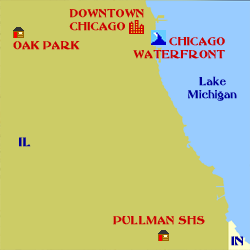

To move forwards or backwards through the Chicago trail click the arrows above, or select your next destination on the Minimap.
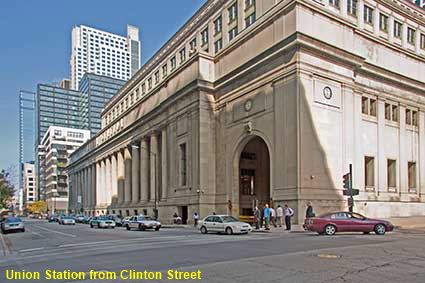
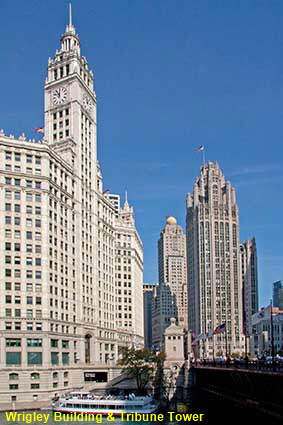
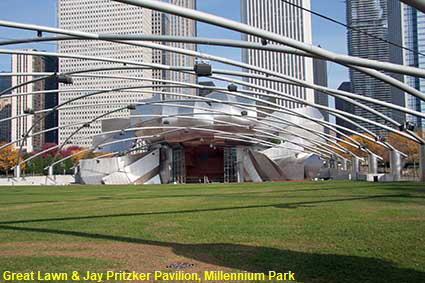
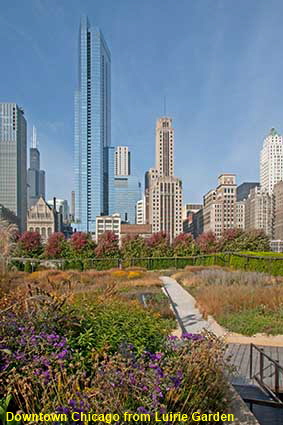
Downtown Chicago from Luirie Garden, Millennium Park
At the southern end of Millennium Park is the 1 hectare (2.5 acre) Lurie Garden, designed by Kathryn Gustafson, Piet Oudolf, and Robert Israel. This quiet oasis provides a magnificent view of skyscrapers old and new in the bustling downtown area.
© Mike Elsden 1981 - 2025
The contents of this page may not be reproduced in full or in part without permission